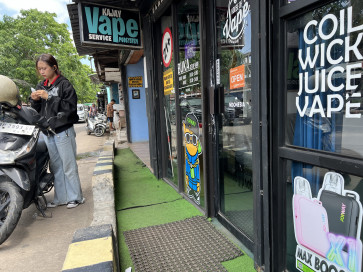Popular Reads
Top Results
Can't find what you're looking for?
View all search resultsPopular Reads
Top Results
Can't find what you're looking for?
View all search resultsMining, deforestation threaten endemic black macaque
Widespread mining operations and deforestation are endangering the lives of Tonkean macaque monkeys, also known as the Sulawesi black macaque, in Central Sulawesi and Gorontalo
Change text size
Gift Premium Articles
to Anyone
W
idespread mining operations and deforestation are endangering the lives of Tonkean macaque monkeys, also known as the Sulawesi black macaque, in Central Sulawesi and Gorontalo.
In Central Sulawesi, the monkeys are found in the forests between North Palu and Tana Toraja, and south of the Lore Lindu National Park, which covers the eastern part of the peninsula.
They are also often seen in the Bale and Lapaloang hills in Banawa, Central Sulawesi, which lie on the fringes of villages along the Banawa coast and Donggala city, and in the Podi forest in Tojo Una-Una regency, a two-hour drive from regency's capital, Ampana, also in Central Sulawesi.
However, in the past four months, the Tonkean macaque monkeys in the forest around Podi village in Tojo Una-Una regency have been deserting their natural habitat and have begun to encroach upon villages and farms.
Local resident Subhan Lasawedi said until recently, he had never seen the monkeys on the road leading to his village of Ampana, but now he had to drive slowly and carefully to avoid hitting them.
A campaigner with the Central Sulawesi branch of the Mining Advocacy Network (Jatam), Muhammad Rivai M. Hadi, said the monkeys had left their habitat due to iron ore mining in Podi village.
'We believe the macaques have left because of deforestation in the area and the noise from the mining equipment,' Rivai said.
Another local, M. Farhn, said villagers did not want to disturb the macaques, but they had to gtet them off their land as the monkeys ravaged their farms and oil palm trees.
Rivai added that the number of macaques in local villages was multiplying by the day due to the sound of machinery operating around the clock.
'We are concerned that if the mining continues unchecked, large groups of macaques may start to attack people and destroy more crops. There is also a risk that this indigenous species will become extinct,' he said.
Meanwhile, in Gorontalo regency, much of the natural habitat of several endemic species, including the macaque; the anoa ' also known as the midget buffalo; the tarsius, and the babirusa or deer hog, has been destroyed by more than 20 illegal gold mines.
Muchtar Maksum, head of the Nantu Wildlife Refuge (SMS), which has rescued a number of these animals and 35 species of bird native to Sulawesi under the auspices of the Gorontalo Natural Resources Conservation Agency (BKSDA), maintained that around 500 miners were operating at each of the gold mines.
Water in the Nantu River is now very murky due to the widespread use of high-pressure water pumps, generally used by miners to search gold by abrading hills in the area.
This mining technique has also led to the collapse of many trees as a result of soil erosion.
A number of land disputes has also added to the worsening situation.
In accordance with Forestry Ministerial Decree No. 325/2010, the conservation area, which was previously 31,215 hectares in size, has been expanded to 51,507 hectares.
'Many miners claim their mines are located outside the conservation area,' Muchtar said.
The BKSDA's Gorontalo office once measured the entire boundary of the expanded area and encountered angry locals in areas such as Asparaga district, which lie in close proximity to the conservation area.
'An oil palm plantation is operating on their land, which also breaches the area. They remain steadfast that their land is located outside the Nantu conservation area,' he added.
The conservation area is guarded by only six volunteers, when it should in fact be protected by 51 personnel, or one guard overseeing 1,000 hectares.










